Nina Notman looks at attempts to reduce the environmental impacts of small-scale gold mining
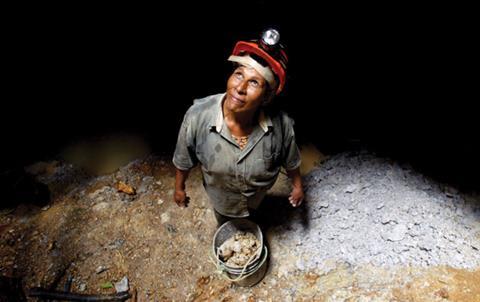
The world has a hunger for gold: each year we mine around 2500 tonnes for use in products ranging from dental fillings to satellites. Between 15 and 20% of this gold is dug up by artisanal and small-scale miners. This informal sector comprises individuals or small groups, working with rudimentary tools. There are an estimated 10–15 million small-scale gold miners operating in approximately 70 different countries. Taking into account their families, the sector is believed to be increasing the personal incomes of 100 million of the world’s poorest people by about five times. But many of these miners are paying for their increased wealth with their health – and so is the rest of the world.
Many small-scale miners use mercury to extract gold from crushed ore or sediment. Mercury and gold form an amalgam, which is then heated to evaporate off the mercury and obtain the gold (often called sponge gold because it contains holes where the mercury was). Further smelting removes impurities and produces a higher purity solid gold. This step is often carried out in gold shops.
Small-scale miners are thought to be using more mercury per year than any other single sector. The UN Environment Programme (UNEP) estimates that they use roughly 1600 tonnes of mercury annually to produce around 450 tonnes of gold. This accounts for approximately a quarter of the global consumption of mercury.
The World Health Organization has reported that the air vapours around locations where amalgam is heated can be ‘alarmingly high’ in mercury, and almost always exceed limits for safe exposure. It’s not only the workers who breathe this in, but also the communities that live near the burning sites. And it’s not just the air; spillages, direct discharge of mercury-contaminated tailings into water bodies, and settling vapour means the soil and waterways in the vicinity are contaminated too.
Many people with high levels of mercury in their bodies have few or no symptoms, at first at least. However, in unborn babies and young children – who are much more sensitive to its effects – mercury can cause neurological damage. And after many years of exposure, adults can also succumb to its effects.
Mercury pollution is not just a local issue. It is a persistent pollutant and is transported around the globe by major winds and ocean currents. Once the vaporised mercury reaches the soil or water, bacteria and other anaerobic organisms transform it into methylmercury. This is then absorbed by phytoplankton, which are then ingested by zooplankton and fish, contaminating the global food chain.
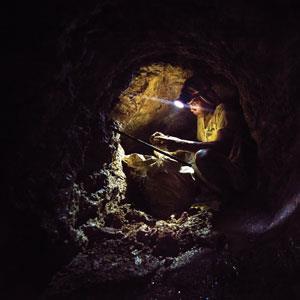
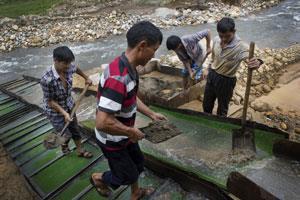
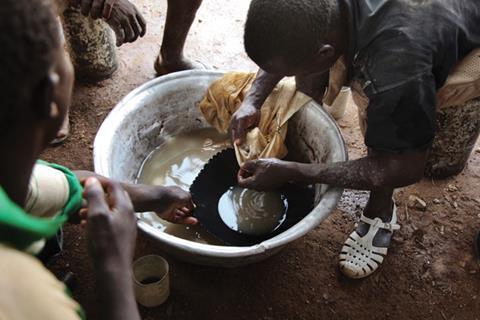
Small-scale gold mining is the largest source of mercury pollution to the air. UNEP reported that the sector was responsible for 37% of all anthropogenic mercury emissions to the atmosphere in 2010. It is also widely cited with being the largest single source of mercury pollution to water, but there are currently no good estimates of how much the miners discharge to water bodies to back this suspicion up.
Moving away from mercury
This is not news: projects have been running for years to try and reduce mercury use by small-scale gold miners. But so far these have had minimal impact: most of these 10–15 million miners still use mercury. ‘From a strictly technical point of view, mercury is a great technique – it’s cheap and it’s [fairly] efficient – and that makes its phase-out in the sector very difficult,’ explains Manuel Caballero Alarcon, an industrial development officer at the UN Industrial Development Organization (UNIDO).
Efforts to reduce mercury use in the sector are escalating, with the pending enforcement of the Minamata Convention on Mercury. This global agreement is designed to protect both humans and the environment from the negative effects of mercury from all sources, not just gold mining. Agreed in 2013, the convention needs a total of 50 countries to ratify it before it comes into effect. ‘19 countries already have ratified, and there are a lot that are on the cusp. The thought is that they are going to start to domino in the next year, with most people predicting that some time in 2016 the convention will go into force,’ says Susan Egan Keane, an environmental analyst at the Natural Resources Defense Council. This US-based non-governmental organisation (NGO) has been collaborating with UNIDO on efforts to reduce mercury use in small-scale gold mining.
When the convention comes into force, countries that host ‘more than insignificant’ amounts of small-scale gold mining will have three years to complete a national action plan outlining how they will tackle the sector’s mercury use. Before they can do this, many of these countries will need to do extensive information gathering. ‘In the majority of the countries, neither the government nor organisations working with them have a clear picture of what the sector looks like,’ explains Caballero Alarcon. ‘It is important as a starting point that they have a clear understanding of the sector in order to be able to better address the challenges.’ Some countries have already started work on information collection and action plans.
The convention does not categorically ban the use of mercury in gold mining, explains Egan Keane, as it is recognised that previous attempts to do this have been unsuccessful. ‘The requirement of the convention is that countries have to reduce the use of mercury in small-scale mining and where feasible to eliminate it.’
There is also flexibility regarding timelines to meet agreed reduction targets once the plans are complete. ‘Small-scale mining is an extremely diverse sector; there are countries where you have 5000 to 10,000 miners in the whole country all using very rudimentary techniques and other countries where they have hundreds of thousands of miners using big earth-moving equipment that still come under small-scale mining,’ explains Egan Keane. ‘In a country where you have 5000 miners it might take five years or less, but in a country like Zimbabwe where they claim to have a million miners, it’s going to take a lot longer.’
Shaking the gold out
But what alternatives are there? Large-scale commercial gold mines use sodium cyanide solution to dissolve and separate gold from crushed ore, a process known as chemical leaching. While sodium cyanide is extremely hazardous and toxic to aquatic life, unlike mercury it does degrade and is not persistent in the environment. However, if mishandled its ill effects are far more immediate than those of mercury.
We tend to use enhanced versions of things that miners are already familiar with
Most NGOs promote advanced gravitational rather than chemical separation methods for small-scale gold mining. ‘Gold is very heavy and it can be separated from other minerals using gravity,’ explains Kevin Telmer, director of the Artisanal Gold Council, a Canadian-based NGO.
Gravitational techniques are already familiar to many miners, as rudimentary versions are often used to create a concentrate before adding mercury. A typical method is to run ore-and-water slurry down an inclined plane over a rough surface such as a carpet to trap the gold; the carpet is then washed to produce the concentrate. These sluices reduce the amount of mercury required.
‘We tend to use enhanced versions of things that miners are already familiar with,’ Telmer says. Examples of advanced gravitational methods include vortexes, centrifuges and shaking tables. ‘We particularly like shaking tables because they’re very intuitive and very visual.’ A typical process set-up by the Artisanal Gold Council involves grinding up the rocks and sediment with crusher and mill, an initial concentration step with a sluice (the waste from which runs off into a tailings pool), then a second concentration step with a shaking table that produces a nearly pure gold stream. This gold is then refined by the miners themselves using direct smelting. This process uses borax (sodium tetraborate) or another flux to aid impurity removal and is very similar to the approach used is most gold shops to turn sponge gold into solid gold
A basic gravity concentration followed by amalgamation typically extracts just 40% of the gold present in an ore or sediment, whereas advanced gravimetric systems on average capture 70% of the gold. ‘There is an economic incentive for the miners,’ Telmer says. But the equipment for these enhanced gravimetric methods is not cheap. He says the entire set up costs about $80,000 (£53,000) – equivalent to about 2kg of gold – to buy, ship, transport, install, commission and finally train a group of miners to work it. The NGO typically spends two years on the ground training and supporting each community of miners as they transition away from mercury use.
The community then pay back the set-up cost over time. ‘The idea is that with the 30% extra recovery of gold the 2kg of gold is repaid on some schedule – it could be six months, it could be a year – and then they own it,’ says Telmer. The $80,000 is then available to finance a similar set-up in another community. The Artisanal Gold Council is currently running projects of this type in Burkina Faso, Senegal, Guinea, Nicaragua, Peru and Indonesia.
Chemical leaching of waste water
In some regions, miners use cyanide solutions to recover additional gold from the tailings after mercury extractions. This practice is particularly undesirable because the cyanide makes the mercury more soluble and therefore even more easily distributed into aquatic systems. By contrast, the tailings of the advanced gravimetric systems are unpolluted.

Ideally, Telmer explains, someone will set up a secondary processing operation that collects the tailings from various communities and treats it to extract the remaining 30% of the gold. ‘That is advantageous to both groups because the artisanal miners can sell their waste and get a little bit more money and then the secondary processors are running a business.’
Sodium hypochlorite, in household bleach, is one of the chemicals being explored for this purpose, explains Richard Amankwah, professor of minerals engineering at the University of Mines and Technology in Tarkwa, Ghana. ‘We are doing some trials at the moment on tailings using the hypochlorite. We are looking at teaming up with the Ghana National Association of Small Scale Miners to build processing centres, so that in every district we have a couple of processing centres where these tailings can be leached.’ Leaching gold with chlorine is again not a new idea: it was used in large scale mining before the current, cheaper cyanide process was introduced. ‘Since the chemical is less toxic, I think it will be more suitable for the small scale mining terrain,’ says Amankwah.
Leaching concentrates
There are also chemical leaching systems in existence for using directly on the gold concentrates themselves, rather than on the tailings. ‘Not every gold occurrence is the same,’ explains Telmer. The mineral type hosting the gold determines the technologies that can be used to capture it. ‘It might be that the gold is very fine and is in a mineralogical setting where chemical leaching is the most effective way to capture it. In that case, you would want to concentrate these minerals as much as possible using a gravimetric method and then apply chemical leaching, one that doesn’t produce any toxic by-products.’
South Africa’s national mineral research organisation Mintek has developed one such process called iGoli. It uses readily-available chemicals and equipment, explains Nirdesh Singh, manager of Mintek’s small-scale mining division. The gold concentrate is leached with dilute hydrochloric acid (sold as swimming pool acid) and bleach. The solid impurities are removed by filtration and the gold precipitated out using sodium metabisulfite (a mango preservative). The gases emitted during the leaching process are neutralised using sodium hydroxide. ‘Dependant on the type of gold ore, [the iGoli set-up] can get greater than 80% recovery and 99% pure gold,’ says Singh.
Mintek aims to help groups of miners set up plants, and also provides training on how to work with the chemicals safely. So far, iGoli plants have been set up in Gauteng in South Africa and in Tanzania.
Peaceful coexistence
None of the mercury-free methods developed to date is a direct substitution for mercury. ‘There is no magic bullet,’ says Telmer. They all require upfront set-up costs and overcoming another, more difficult, barrier: land tenure. These miners are often operating on land where the concession has been given to large mining companies. ‘In that context, it’s very difficult to capitalise their operation to eliminate mercury. What we try to do is find a solution which we call peaceful coexistence.’
The small-scale miners and large-scale mining companies do not normally mine the same gold deposit types. ‘The large company is looking for a very large deposit that will allow them to justify a massive capital expenditure, those are usually low grade and very deep. Artisanal and small-scale miners can’t mine that kind of a deposit, they’re usually working on small, high-grade veins,’ Telmer says. Large-scale companies will therefore sometimes permit small-scale miners to work on their land.
Resorting to retorts
As an interim measure to reduce mercury pollution – and for miners who will be unable to eliminate mercury long-term for whatever reasons – there has been a push to encourage the heating of the amalgam to be done inside mercury capturing devices called retorts. These are not however very popular with miners and, while fairly widely distributed, are rarely used. They can also have unintended consequences if used incorrectly.
If you’re capturing 80% of the mercury, there is still a huge amount being emitted
‘Retorts are sometimes a mixed blessing. They certainly reduce emissions of mercury to the environment but can expose the immediate local community to higher levels of mercury,’ explains Telmer. ‘That’s because when you use a retort, you create an object that is highly contaminated in mercury and that object can be kept under a bed, at home, in a car.’ Also, communal retort are sometimes set up in the middle of villages. ‘If you’re capturing 80% of the mercury, there is still a huge amount being emitted in the middle of your community.’
Most retorts are opaque and the mining community have rejected them largely due to the belief gold is somehow lost from the closed system. In an effort to address this, UNIDO distributed glass retorts but these were rejected for being too fragile.
Efforts are therefore being undertaken to make versions that miners are happy to use. Amankwah, for example, is working on a retort with a glass window. ‘The lantern retort has a window through which a small-scale miner can see what is happening to the amalgam,’ he explains. ‘So far it has been tested in the laboratory, and it is working well.’
While obvious changes need to be made to slash the public health and environmental impact of small-scale gold mining, and the Minamata convention will help with that, no-one wants to squash the sector’s productivity. As a development opportunity, artisanal gold mining is tremendous, explains Telmer. ‘It is a wealth-creation system for the world’s poor. We just need to help them do it responsibly.’
Nina Notman is a science writer based in Salisbury, UK



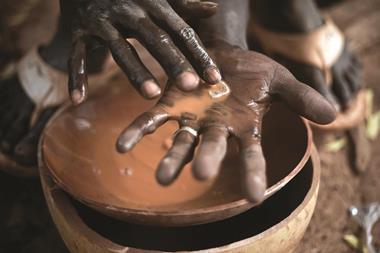








No comments yet